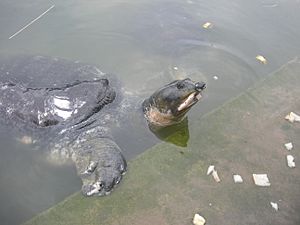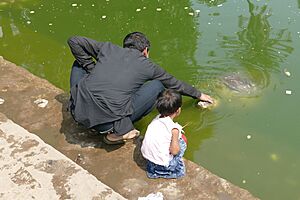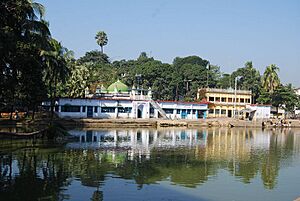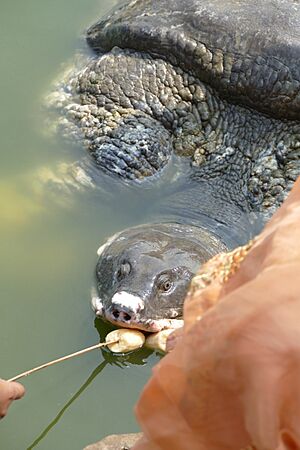Black softshell turtle facts for kids
Quick facts for kids Black softshell turtle |
|
|---|---|
 |
|
| Conservation status | |
| Scientific classification | |
| Genus: |
Nilssonia
|
| Species: |
nigricans
|
| Synonyms | |
|
|
The black softshell turtle or Bostami turtle (Nilssonia nigricans) is a special kind of freshwater turtle. You can find it in parts of India (like Assam and Tripura) and Bangladesh (Chittagong and Sylhet). For a long time, people thought these turtles were just a different type of Indian softshell turtle. But scientists now know they are their own unique species!
In the 1800s, people believed these turtles were brought from Iran to a pond in Chittagong by a holy person named Hazrat Bayezid Bostami. The turtles in this pond were seen as sacred and were highly respected. The International Union for Conservation of Nature (IUCN) even declared them extinct in the wild in 2002. But luckily, they were later found alive in temple ponds in Assam and Tripura, India. Today, thanks to conservation efforts, some of these turtles are slowly returning to the wild. Scientists are working hard to protect this endangered species and its home.
Contents
Where Do Bostami Turtles Live?
The black softshell turtle originally lived in the lower Brahmaputra River area. However, the most well-known group of these turtles lives in a special pond. This pond is part of the Bayazid Bostami shrine in Chittagong, Bangladesh. Here, the turtles rely on people for their food and care. Locals call these turtles mazari, which means "shrine inhabitant." The first scientific descriptions of this turtle came from specimens found at this shrine.
In 2014, a survey found that the oxygen levels in the shrine pond were very low. This is not good for the turtles. Luckily, small wild groups of these turtles have been found in other places. These include Sylhet in Bangladesh, and Kaziranga and the Jia Bhoroli River in Assam, India. More temple populations have also been found. These are in the Kasopukhuri pond near the Kamakhya Temple in Guwahati, Assam. Another group lives in Kalyan Sagar lake at the Tripura Sundari Temple in Udaipur, Tripura. You can also find them in a pond at the Baneswar Shiva temple in West Bengal, India.
What Do Bostami Turtles Look Like?
Their Unique Appearance
The black softshell turtle looks quite different from a common turtle. Like all softshell turtles, it has a flexible, leathery shell. This shell is not hard like a typical turtle's shell. It allows them to move more easily.
This turtle also has a very distinct nose and face. Its nose has a tube-like structure that sticks out. It works much like a snorkel, helping the turtle breathe underwater. Their limbs are also unique. They have webbed, hand-like structures instead of the wider flippers seen on sea turtles. The soft shell does not stick out much from their body. It usually looks quite plain, with little color or design. The skin of the black softshell turtle is often black or dark brown. But it can also have white to yellow spots on its head and limbs.
Size and Weight
Adult Bostami turtles can be quite large. Their shells can range from about 15 to 31 inches wide. Their length can be from 13 to 28 inches. The largest recorded length for these turtles is 35 inches.
Female Bostami turtles usually weigh around 120 pounds. The weight of males has not been officially recorded yet. However, males often look bigger than females. This suggests they might weigh more.
Life Span and Survival
People living near the Bostami turtles claim some of the oldest ones are around 150 years old! However, these turtles face a tough start in life. A very high number of their eggs (about 94%) do not hatch.
A female turtle usually lays about 20 eggs in one group, called a clutch. With such a low hatching rate, only about one egg might survive for every two mating turtles. This makes their early life very challenging.
What Do Bostami Turtles Eat?
Many Bostami turtles live in small areas with lots of human visitors. Because of this, they have become used to being fed by people. Visitors often give them a mix of grains, fruits, and different meat products. This direct feeding has made the turtles dependent on humans. They no longer need to hunt for their own food.
This makes it hard for scientists to know what their natural diet is. However, since they can eat the food provided by people, their diet is thought to be similar to other turtles in their group. These turtles are omnivores. This means they eat both plants and small animals, like fish and worms.
How Do They Reproduce?
Black softshell turtles reproduce by laying eggs. This means they are "oviparous." Softshell turtles grow up slowly. Males are ready to breed around their fourth year. Females take longer, usually seven to nine years to mature.
A female black softshell turtle can lay anywhere from 10 to 38 eggs in one clutch. The baby turtles will grow inside their eggs for about 92 to 108 days before hatching. Sadly, the hatching rate for this species has been going down recently. This is because they are an endangered species.
Bostami Turtle Behavior
Hibernation
Softshell turtles go into hibernation from late autumn until spring. During this time, they bury themselves in the mud at the bottom of a river or lake. Food is not as important during hibernation, but oxygen still is. Turtles need less oxygen than usual during this period.
They use a special technique called "pharyngeal breathing." This means they pump water in and out of their throat (pharynx). Their throat has tiny blood vessels that help them absorb more oxygen from the water.
Why Were They Nearly Extinct?
In 2002, the International Union for Conservation of Nature (IUCN) officially said the black softshell turtle was Extinct in the Wild. This meant they thought there were no more left in their natural habitat. But in 2004, over 400 turtles were found in the pond at the Bayazid Bostami shrine! More turtles have hatched there since then, showing they are still around.
In 2017, a single wild turtle was found in Nagaland, India. DNA tests confirmed it was a black softshell turtle. This was exciting news!
The main reason these turtles faced extinction was human activity. As people moved into their habitats, it led to pollution of water and land. The survival rate for young black softshell turtles is very low. Many eggs don't hatch, and many young turtles don't survive after hatching.
Keeping black softshell turtles in temple ponds for religious reasons has both good and bad effects. The shrines protect the turtles from predators. However, these ponds are often not ideal for the turtles to reproduce and grow naturally. In Hinduism, the black softshell turtle represents a god named Kurma. Worshipers often feed the turtles human foods like biscuits. These foods are not good for the turtles and can cause them to be unhealthy.
Human actions have also caused harm through intentional poisoning. In 2006, there was a mass poisoning event in the Bostami Shrine pond. This was done by people who wanted to harm the turtles. Many fish that the turtles ate were poisoned. This made it hard for the turtles to find food. The poisoning also lowered the oxygen levels in the water, making it unsafe for the turtles. After a waiting period, the water became healthy again, allowing the turtles to be released back into the pond.
How Are People Helping?
Since 2013, a group called TSA India has been working hard to improve conditions in temple ponds in Assam where these turtles were found. Many of these ponds were dirty and overcrowded. Turtles were often fed human food as religious offerings. This caused the turtles to be unhealthy. Also, there wasn't enough good space for them to lay eggs, so many eggs didn't hatch.
The main goal of this project is to raise young turtles and then release them into the wild. This will help increase the wild populations. As part of this, the TSA India team observed nesting at the Nagshankar temple. They moved some nests to a special hatchery and protected others.
Thanks to TSA's efforts, 44 turtles have hatched so far! The team is making a bigger facility at Nagshankar temple to care for the baby turtles. Young turtles cannot be released directly into the temple pond because bigger turtles and other fish might eat them. So, the team got a natural pond in a nearby village. This gives the fast-growing young turtles a safe place to live, improving their chances of survival.
From 2006 to 2012, scientists observed that the number of black softshell turtles slowly increased. However, this also meant that the space available for each turtle decreased. Scientists say that without more habitat space, the turtle population might stop growing. This could prevent them from getting out of their endangered status.
In 2011, Dr. Jayaditya from the Help Earth NGO found a group of black softshell turtles in a temple pond in Hajo, Assam. He helped restart efforts to save and increase the species. His team improved the pond to make it more like a natural river system. This helped the turtles lay more eggs. The State Zoo of Assam also plays a big role. They raise baby turtles for six months. Once the young turtles are strong and healthy, they are released into the wild. As of 2016, the State Zoo of Assam has released 300 turtles! Now, 16 temples in Assam are helping with this important project. Similar conservation work is also happening in Tripura to protect the local Bostami turtle populations.






